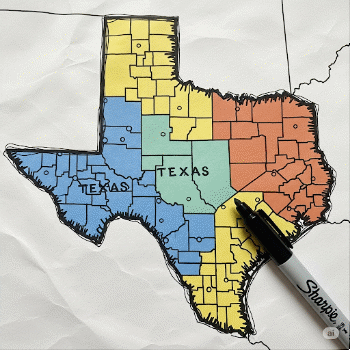
Aren’t there any grown-ups in the room?
This political theater over redistricting is a masterclass in childish behavior, prioritizing partisan one-upmanship over the foundational principles of democracy. Instead of engaging in the hard work of finding a fair, lasting solution, both sides are content to lob retaliatory grenades at each other. The Texas Republicans’ attempt to redraw maps mid-decade for political gain is now met with the California Democrats’ threat to dismantle their own independent commission—a system voters approved to prevent exactly this kind of power grab. It’s a textbook case of “if you can’t beat ’em, cheat ’em,” where the rules are bent and broken in a cycle of escalating belligerence. This behavior isn’t just unproductive; it’s deeply damaging to the public’s trust in the political process, making it seem less like a civic duty and more like a playground fight where the biggest bully wins.
The History and Constitutional Basis of Redistricting
In the early days of the republic, districts were often based on existing town or county lines. However, as populations shifted, some districts became significantly larger than others, leading to unequal representation.
The Constitution grants state legislatures the power to regulate the “times, places, and manner” of congressional elections. The most important constitutional principle related to redistricting is the “one person, one vote” rule, established by the Supreme Court in the 1960s. This principle, derived from the Equal Protection Clause of the 14th Amendment, requires that all congressional and state legislative districts have roughly equal populations.
The Voting Rights Act of 1965 also plays a critical role, prohibiting redistricting plans that dilute the voting power of minority groups. While the Supreme Court has set limits on racial gerrymandering, it has been more hesitant to intervene in cases of partisan gerrymandering, which makes no sense. This ultimately left it to the states to regulate the issue. Until this administration.
The Modern Redistricting “Nightmare” in Texas and California
The current redistricting nonsense highlights the deep partisan divisions and the ongoing struggle for power between the two major parties. The issue has been ignited by Texas Republicans, who, at the urging of President Donald Trump, are pushing for a mid-decade redistricting plan. Their proposed map aims to create several new Republican-leaning districts, which would significantly strengthen the GOP’s slim majority in the U.S. House. In response, dozens of Texas Democrats left the state to deny the legislature the quorum needed to pass the new maps, a tactic they have used before.
In retaliation, California Democrats are threatening to redraw their own congressional maps. Unlike Texas, California has an independent commission that handles redistricting after each census. However, Governor Gavin Newsom and state Democrats are considering a proposal to bypass the commission and let the state legislature draw a new map that could eliminate up to five Republican-held seats.
Both Sides are Being Childish and Not Trying to Fix the Problem
The public’s frustration with the stupid and unproductive fighting over districts is not merely an inconvenience; it is a symptom of a deeper systemic issue that challenges the foundational principle of “one person, one vote” and, public faith in the electoral process.
The current situation is a prime example of political brinkmanship, where both parties are more concerned with gaining an advantage than with creating a fair and representative system. They are more concerned with making Trump happy and keeping their jobs than they are about the people they represent.
Since neither side seems to have an adult in the room, we can either just let this happen, or start voting for leaders; if we can find them. We can also break this down so that even current Republican and Democratic politicians might understand.
The Census
Donald Trump has said he wants a new census. His reason is simple. He wants to use that to draw up new districts. The U.S. Constitution mandates a census every ten years for reapportioning congressional seats, and any significant changes to the process would require a new law passed by Congress. He can have his new census, but the new numbers can only be used for federal funding allocation. They cannot use the new numbers for political redistricting. Someone needs to tell him that.
What Congress can and should do
Eliminate the Electoral College
First, so this is never again an issue for the Presidential voting, Congress should immediately eliminate the Electoral College. There were two main reasons the framers of the Constitution compromised and came up with this convoluted system. One, they want the power to go to electors because they thought they would be more informed than the general population. With 24-hour news and the Internet, everyone can be equally informed. Anyone taking the time to read this article is just as informed about the issues facing this country as any elector. The second is the Electoral College, also served as a compromise related to slavery. The Southern states had more people if you counted the slaves, just not more voters. Another non-reason for it to exist.
Congress can pass a law that the census is only taken every 10 years
A crucial reform for enhancing electoral stability is to pass a law limiting a census taken only every ten years, with no exceptions. Since neither the U.S. Constitution nor federal law explicitly prohibits taking the census in off years, clarity is imperative. Congress has the authority and the responsibility to put a stop to this silliness.
Limit redistricting to the same 10 years
Limiting congressional redistricting to once every ten years, following the census, is a critical reform for electoral stability. The current system, which allows for mid-decade redistricting, fuels continuous partisan conflict. A decennial-only mandate would increase predictability and reduce politically charged redistricting fights.
Congress can implement this change using its authority under the Elections Clause (Article I, Section 4) of the Constitution. This clause empowers Congress to regulate federal elections, a power the Supreme Court has interpreted as “paramount.” This constitutional authority, supported by historical precedent and past legislative efforts, means that the chief obstacle to this reform is political will, not a constitutional barrier.
Establishing Uniform Redistricting Boards
Currently, redistricting is conducted by either state legislatures or commissions, with methods varying significantly across states. The need for consistent, non-partisan redistricting boards in all states is a call for a standardized approach that would prioritize fair representation over political gain, becoming more responsive to the will of the people.
The latest breakdown of voters is 30% Democrat, 30% Republican, and 40% independent. If one party gets to draw the map, then 70% of the voters get left out. That is not what the framers intended.
Congress could set up a uniform set of rules so that each state has a board made up of Democrats, Republicans and Independents. A 12-member (4/4/4) board that is elected or appointed for 4-year terms, with staggered appointments, replacing three members every year. None should be re-elected.
The Supreme Court’s Arizona v. AIRC ruling affirmed states can use independent redistricting commissions. While not directly addressing federal power, it supports the idea that Congress can mandate such commissions for all states. The Elections Clause gives Congress “paramount” power to regulate elections, suggesting a strong constitutional basis for setting uniform redistricting standards. This makes the reform’s feasibility a political, not a legal, challenge.
At the same time, they can set up the criteria for how the districts can be drawn.
Summary
Our nation stands at a crossroads, facing a stark choice between continuing down a path of intense partisanship or forging a new one based on cooperation and fair representation. This new path is only possible if we can ensure free and fair elections, and the ceaseless conflict over gerrymandering must end for that to happen.
What we have now it the equivalent of Donald Trump changing the path of a hurricane with a Sharpie.
Gerrymandering undermines the principle of “one person, one vote.” It allows politicians to choose their voters, rather than the other way around, leading to non-competitive elections and a lack of accountability.
To restore faith in our democracy, we must find a way to end this cycle of partisan map-drawing. The political will to enact such reforms is the only obstacle. By ending gerrymandering, we can create a system where every vote truly counts, fostering a more representative and stable government for the future.



